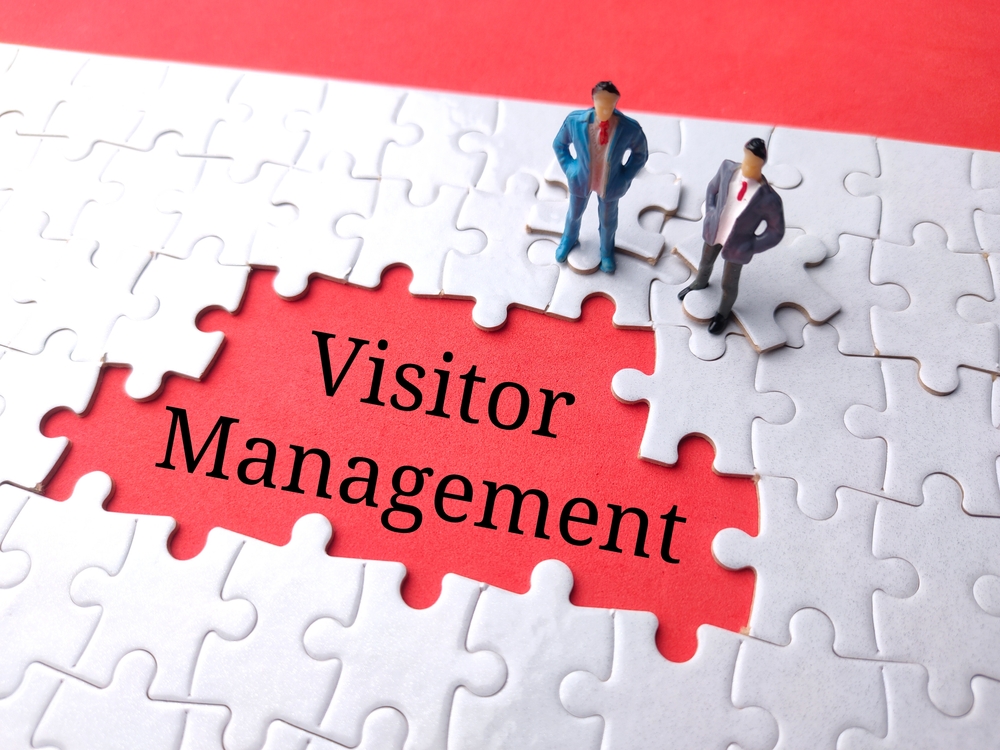Visitor management is an important part of making a great first impression on your visitors, as well as protecting their privacy and increasing safety. Facilities managers should therefore work with security leaders to implement a modern visitor management solution (VMS) that would adequately greet, process, and monitor those entering your facility.

How Should It Be Set Up?
Most facilities have a front lobby at the main entrance. Traditionally, guests stop to check in at the reception desk and sign in using a pen and paper.
However, a VMS can use video cameras to identify guests as they enter, have a self-service check-in kiosk requiring an ID scan, and allow guests to use an app on their smartphones for a touchless experience, which is also helpful for guests who make appointments. A self-service printer can also make visitor badges, which reduces the workload on security personnel.
Learn about how a VMS can streamline your visitor management process by reading “How Buildings Can Optimize Visitor Management with Digitization” on Facilities Management Advisor.
Does It Replace Receptionists?
The modern VMS doesn’t have to replace front desk receptionists, who can still welcome visitors and provide additional assistance. They can perform administrative tasks and contact security personnel if they observe suspicious activity, as well. A VMS can serve as an aid to receptionists who might be on a break, on a phone call, or working with a guest when a visitor walks into your facility.
Who Should Have It?
Industries that are most likely to have a VMS include medium to large-size corporate office facilities, as well as healthcare, hospitality, educational, and governmental buildings. Many of these facilities will use these systems for customers, contractors, consultants, and freelancers. To learn more about VMS contractor solutions, check out “Streamlining Visitor Management for Contractors” on EHS Daily Advisor.
7 Problems a VMS Can Help Solve
Some of the problems a VMS can help solve for facilities and security managers include:
1. Banned Individuals
VMS cameras and kiosks can use internal watchlists to flag banned visitors who shouldn’t be allowed entry. Additionally, visitors can be checked against federal and state criminal databases, as well as sex offender registries. Alerts can also notify security instantly if a visitor is on any watchlist.
2. Facility-wide Access for Visitors
Visitors should have limited access to the facility for a specific time. Visitor badges should not just include the individual’s first and last name but also have a photo and the areas the person has access to. Facilities and security management teams should also ensure there are proper physical access control measures to prevent visitors from entering restricted areas.
3. Privacy Regulation Violations
A paper-based visitor log with confidential information can be visible to anyone visiting the lobby. VMSs can protect this information, inform visitors how data is being used, and ask them to consent. This helps organizations comply with a variety of privacy regulations, such as the California Consumer Privacy Act (CCPA), the General Data Protection Regulation (GDPR), and the Federal Information Security Modernization Act (FISMA).
4. Having Invalid Visitor Data
Handwritten data may not be accurate, complete, or legible, but VMSs allow facilities to track aggregate visitor data, including peak hours, average length, frequent guests and hosts, and reasons for denied entry. This data can then be used to make informed decisions about facility operations, receptionist and security staffing, and other resources.
5. OSHA Violations
Visitors entering and exiting specific facilities like hospitals and medical buildings, as well as other high-hazard facilities, should meet Occupational Safety and Health Administration (OSHA) training guidelines. VMSs can ask visitors to indicate they’ve been trained and will comply with rules regarding protective equipment via an electronic signature.
6. Unhealthy Visitors
Keep your facility healthy by using VMS technology to take thermal temperature scans of all visitors. This is especially important in areas with high COVID-19, influenza, and respiratory syncytial virus (RSV) rates. Security can be notified if a visitor fails the screening, and the VMS can ask visitors respiratory disease screening questions, as well as their health and vaccination status. It can also inform visitors if there’s a facility mask policy.
7. Lost Guests
When making an appointment, visitors can receive directions and information, through texts and e-mails, regarding the registration area, including parking instructions, floor and office numbers, and maps that show frequently asked-for amenities like elevators, vending machines, and restrooms. Hosts will receive a notification as soon as guests arrive on-site.
Learn More
A VMS will help solve problems regarding prohibited individuals, facility-wide access, privacy regulation violations, invalid visitor data, OSHA violations, unhealthy visitors, and lost guests.
But before implementing a VMS, facilities and security managers should do a comprehensive review of their visitor’s policy. Learn how to do that by reading “Developing and Implementing a Workplace Visitors Policy” on Facilities Management Advisor.
